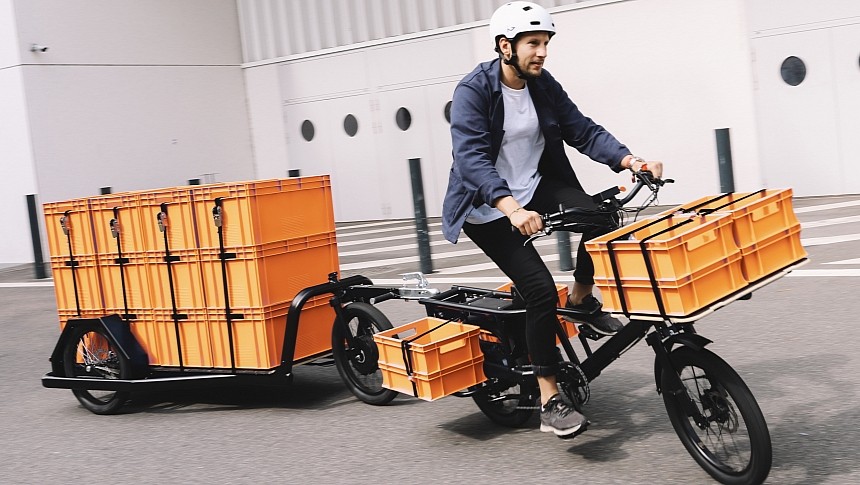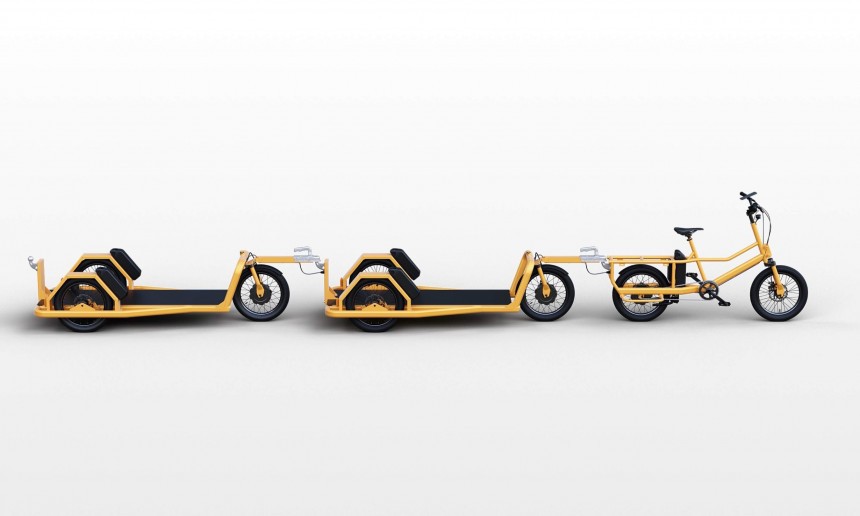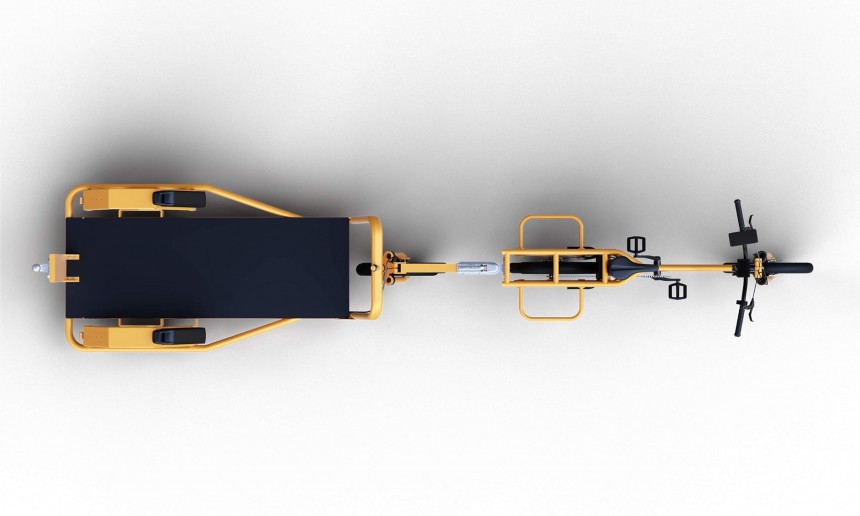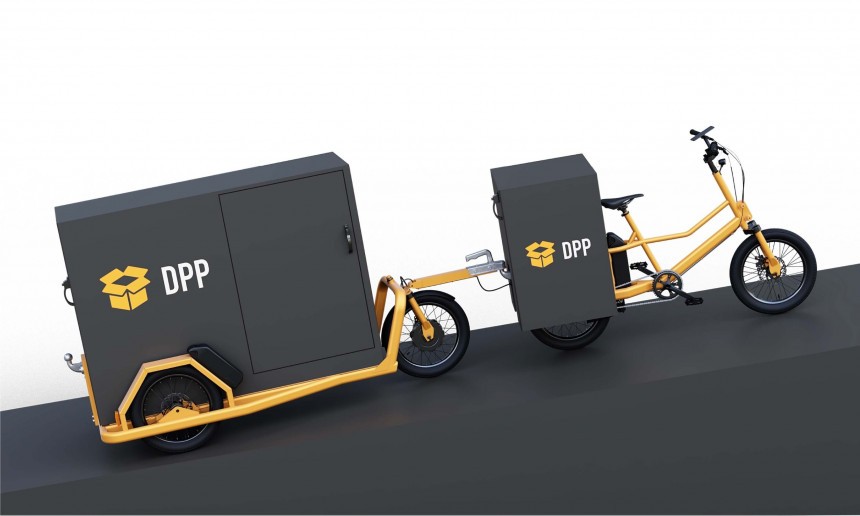With each passing day, e-bike design is getting wilder and wilder. Well, taking things one step further, we have France's Pelican and their Train platform. Think of it as the ultimate cargo e-bike, capable of hauling up to 1,103 lbs (500 kg).
So, we've seen cargo bikes before, but what Pelican Cycles has achieved with their Train platform is downright genius from countless standpoints. In this spirit, I've decided to shed a bit of light on what's happening over in Europe. Heck, this trend could very well take to the streets of the US.
If the name Pelican Cycles is new to you, you aren't alone, but this team has been around since 2021, when two designers and engineers with experience working with Decathlon and Fabernovel got together to start their own brand. Since then, this crew has really taken off, and these days, they offer countless cargo e-bike solutions.
However, their freshet machine, the Pelican Train, breaks away from any classic designs we may have seen. Oh, and if the images in the gallery aren't enough to help you understand what's going on here, think of the Train as just that, an e-bike with train-like abilities or an 18-wheeler with a couple of trailers.
Now, what makes the Train rather interesting is the way the bicycle portion of the bike and trailer interact. That's right; the two are designed to work together during propulsion, braking, and even parking. All this isn't just for functionality but safety, too. After all, hauling around over 1,000 lbs of cargo can clearly be dangerous.
To understand how things work, let's break down this design into its two - sometimes more - distinctive parts: the bike and the trailer(s).
The bicycle itself is rather simple and, much like other cargo bikes, features plenty of space for bins and goods. A rear and front rack design is responsible for this, and while some of the cargo solutions we're shown may appear to raise the center of gravity of the Train, its smaller wheels (possibly 20-inch tires) and low-to-the-ground framework ensure stability during turns. Tire width has also been maximized for adequate grip.
Then there's the matter of power. Overall, each Train sports a 250 W motor with the ability to squeeze out 111 Nm (82 lb-ft). That'll do it for power. But what about range? Well, according to the manufacturer, the Train's battery pack can achieve a peak of 50 km (31 mi) on a maximum charge. Sure, the range is rather lousy, but we'll get into why shortly.
As for the trailer, it too is powered by yet another 111 Nm motor, and the best part of it all is the fact that these two motors are working together to haul your load. This is achieved through a proprietary "motor synchronization" method. That's just a fancy way of talking about wires, chips, and software, or controllers for short. Braking works the same way, ensuring you don't jackknife around some campus or neighborhood.
While 250 W and 111 Nm may not sound like a whole lot, something magical happens when these two or more sections are connected: a cargo-hauling giant is born. According to Pelican, at full load, these motors are strong enough to handle an 18% slope.
All that power is bound to suck the juice right out of any and all batteries strapped to the Train. For example, each bike has a removable battery hidden underneath the saddle, but once you start hooking up trailers to the bike, each one brings yet another two packs to the game.
As for how we got here and why, there are several angles we need to approach this shift toward cargo services that are centered around the e-bike. First of all, Pelican is active in Europe, where bicycles have been a reliable means of transportation for decades.
I'm not saying North America doesn't use bikes; we do, but the infrastructure and geography in Europe simply allow the bicycle to be a viable solution. As a result, networks of bicycle lanes tatter countless cities over the Atlantic, and bicycle traffic simply doesn't seem to exist.
What does this mean for delivery and parcel services? It means an untapped venue through which they can fluidize their services. Sure, a bicycle will never be able to out-distance or even out-perform a car, but for those 50 km or range, to carry up to half a ton of cargo with nothing but good old green energy is bound to shift those profit margins around a little bit. If only there was a solution, wink-wink.
Best of all, because of the whole modular design, the Train's application is quite widespread. From college campuses carrying around sports equipment to groundskeeping, parcel services, and industrial gear around worksites, all are suitable settings where we could spot a Pelican Train.
But how much is the shift toward a cargo fleet full of Pelican Trains going to cost pleased business owners? Well, it depends on how you do business with Pelican. At this time, companies can rent a Pelican train for €15 per day, €45 per month, or, if you want to go all out, €4,500 ($4,850 at current exchange rates) is what you need to put your hands on your first Train.
Yet, there may be a catch to that price. As I explored Pelican Cycles' website, I didn't see anything about a trailer being included in that rate. If that's true, a rental service might be best until you put enough cash aside to initiate the next stage in your delivery service business.
If the name Pelican Cycles is new to you, you aren't alone, but this team has been around since 2021, when two designers and engineers with experience working with Decathlon and Fabernovel got together to start their own brand. Since then, this crew has really taken off, and these days, they offer countless cargo e-bike solutions.
However, their freshet machine, the Pelican Train, breaks away from any classic designs we may have seen. Oh, and if the images in the gallery aren't enough to help you understand what's going on here, think of the Train as just that, an e-bike with train-like abilities or an 18-wheeler with a couple of trailers.
Now, what makes the Train rather interesting is the way the bicycle portion of the bike and trailer interact. That's right; the two are designed to work together during propulsion, braking, and even parking. All this isn't just for functionality but safety, too. After all, hauling around over 1,000 lbs of cargo can clearly be dangerous.
The bicycle itself is rather simple and, much like other cargo bikes, features plenty of space for bins and goods. A rear and front rack design is responsible for this, and while some of the cargo solutions we're shown may appear to raise the center of gravity of the Train, its smaller wheels (possibly 20-inch tires) and low-to-the-ground framework ensure stability during turns. Tire width has also been maximized for adequate grip.
Then there's the matter of power. Overall, each Train sports a 250 W motor with the ability to squeeze out 111 Nm (82 lb-ft). That'll do it for power. But what about range? Well, according to the manufacturer, the Train's battery pack can achieve a peak of 50 km (31 mi) on a maximum charge. Sure, the range is rather lousy, but we'll get into why shortly.
As for the trailer, it too is powered by yet another 111 Nm motor, and the best part of it all is the fact that these two motors are working together to haul your load. This is achieved through a proprietary "motor synchronization" method. That's just a fancy way of talking about wires, chips, and software, or controllers for short. Braking works the same way, ensuring you don't jackknife around some campus or neighborhood.
All that power is bound to suck the juice right out of any and all batteries strapped to the Train. For example, each bike has a removable battery hidden underneath the saddle, but once you start hooking up trailers to the bike, each one brings yet another two packs to the game.
As for how we got here and why, there are several angles we need to approach this shift toward cargo services that are centered around the e-bike. First of all, Pelican is active in Europe, where bicycles have been a reliable means of transportation for decades.
I'm not saying North America doesn't use bikes; we do, but the infrastructure and geography in Europe simply allow the bicycle to be a viable solution. As a result, networks of bicycle lanes tatter countless cities over the Atlantic, and bicycle traffic simply doesn't seem to exist.
Best of all, because of the whole modular design, the Train's application is quite widespread. From college campuses carrying around sports equipment to groundskeeping, parcel services, and industrial gear around worksites, all are suitable settings where we could spot a Pelican Train.
But how much is the shift toward a cargo fleet full of Pelican Trains going to cost pleased business owners? Well, it depends on how you do business with Pelican. At this time, companies can rent a Pelican train for €15 per day, €45 per month, or, if you want to go all out, €4,500 ($4,850 at current exchange rates) is what you need to put your hands on your first Train.
Yet, there may be a catch to that price. As I explored Pelican Cycles' website, I didn't see anything about a trailer being included in that rate. If that's true, a rental service might be best until you put enough cash aside to initiate the next stage in your delivery service business.












